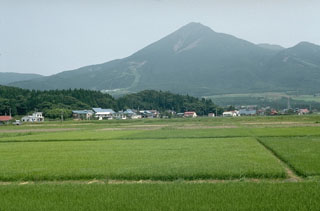Report on Bandaisan (Japan) — June 1987
Scientific Event Alert Network Bulletin, vol. 12, no. 6 (June 1987)
Managing Editor: Lindsay McClelland.
Bandaisan (Japan) Earthquake swarm
Please cite this report as:
Global Volcanism Program, 1987. Report on Bandaisan (Japan) (McClelland, L., ed.). Scientific Event Alert Network Bulletin, 12:6. Smithsonian Institution. https://doi.org/10.5479/si.GVP.SEAN198706-283160
Bandaisan
Japan
37.601°N, 140.072°E; summit elev. 1816 m
All times are local (unless otherwise noted)
An earthquake swarm began 16 June, with 155 events recorded that day by the seismograph 2 km SSE of the summit (table 1). Epicenters were mainly concentrated 10 km SW. Seismicity decreased to
Table 1. Daily number of felt earthquakes at Wakamatsu Observatory, 10 km W of the epicentral area of the Bandai swarm, June 1987.
| Date | Felt Events |
| 16 Jun 1987 | 7 |
| 17 Jun 1987 | 2 |
| 18 Jun 1987 | 1 |
| 21 Jun 1987 | 2 |
| 23 Jun 1987 | 2 |
Geological Summary. One of Japan's most noted volcanoes, Bandaisan rises above the north shore of Lake Inawashiro. This complex is formed of several overlapping andesitic stratovolcanoes, the largest of which is Obandai. Kobandaisan peak, which collapsed in 1888, was formed about 50,000 years ago. Obandai was constructed about 40,000 years ago after a Plinian eruption resulted in the collapse of an older edifice and the Okinajima debris avalanche to the SW. The last magmatic eruption took place more than 25,000 years ago, but four major phreatic eruptions have occurred during the past 5,000 years, most recently in 806 and 1888 CE. Seen from the south, Bandaisan presents a conical profile, but much of the north side of the volcano is missing as a result of the collapse of Kobandaisan during the 1888 eruption, causing a debris avalanche that buried several villages and formed several large lakes.
Information Contacts: Japan Meteorological Agency (JMA).

